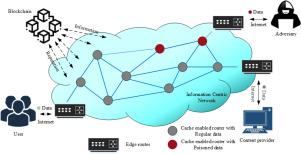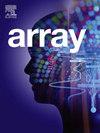Double Layered Blockchain-based trust model for secure interest and data forwarding in Vehicular Information Centric Network
IF 4.5
Q2 COMPUTER SCIENCE, THEORY & METHODS
引用次数: 0
Abstract
Vehicular Information Centric Networks(V-ICNs) which is an alternate to the traditional Vehicular Adhoc Networks (VANETs) is proposed to enable the content-based addressing instead of IP based data access to improve the efficiency of the Vehicular Network. V-ICN is more susceptible to security attacks from several sources because of its wireless, heterogeneous connection style and highly dynamic architecture. In contrast to entity-based security authentication, it is crucial to think about how to safeguard the data’s security. Although reputation based quantification has been used in state-of-the-art research to assess the dependability of interactive data, there are still some problems with the design of safe reputation management systems. This result in low efficiency, inadequate security and unreliable administration. The Double Layered Blockchain (DLB) technique for communication security in vehicle Information-Centric Networks will be presented in this study. It will take into account of both the worldwide reputation of vehicle chain and the one-day local information chain. In this, each vehicle’s activities that are documented in the Local One-day Message Blockchain (LOMB) will be used to update the reputation score of the vehicles on a regular basis. In addition, the proposed work would also include a Secured Neighbourhood Recognition Protocol (SNRP) to introduce flexible connectivity among the vehicle nodes and the blockchain network. Based on the Experimental Analysis, the proposed methodology is outperformed in comparison with the existing models in terms of network throughput, interest success rate, varying interest generation rate and the interest success rate.

基于双层区块链的车辆信息中心网络安全利益和数据转发信任模型
车辆信息中心网络(V-ICNs)是传统车辆自组织网络(vanet)的替代方案,其目的是实现基于内容的寻址而不是基于IP的数据访问,以提高车辆网络的效率。由于其无线、异构的连接方式和高度动态的架构,V-ICN更容易受到来自多个来源的安全攻击。与基于实体的安全身份验证相比,考虑如何保护数据的安全性至关重要。尽管基于声誉的量化已经在最新的研究中被用于评估交互数据的可靠性,但安全声誉管理系统的设计仍然存在一些问题。这导致效率低、安全性不足和管理不可靠。本文提出了一种用于车辆信息中心网络通信安全的双层区块链(DLB)技术。它将考虑到汽车链的全球声誉和一天的本地信息链。在这种情况下,记录在本地一天消息区块链(LOMB)中的每辆车的活动将用于定期更新车辆的信誉评分。此外,拟议的工作还将包括一个安全邻居识别协议(SNRP),以在车辆节点和区块链网络之间引入灵活的连接。基于实验分析,本文方法在网络吞吐量、利率成功率、变利率生成率和利率成功率方面均优于现有模型。
本文章由计算机程序翻译,如有差异,请以英文原文为准。
求助全文
约1分钟内获得全文
求助全文

 求助内容:
求助内容: 应助结果提醒方式:
应助结果提醒方式:


